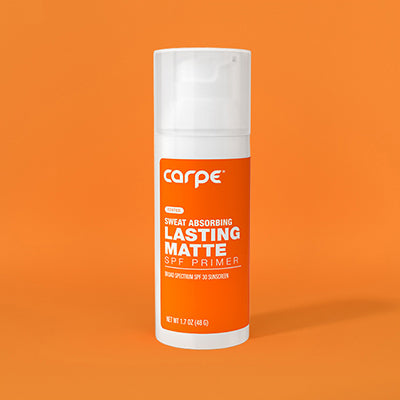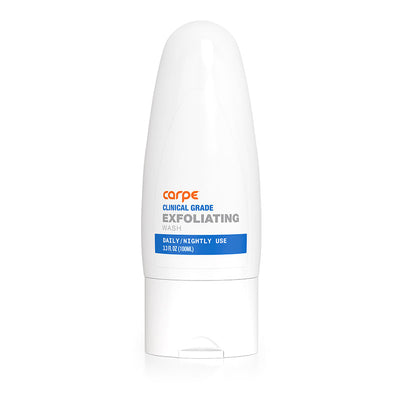Unfortunately, excessive sweating can make using sunscreen extremely frustrating. This is because sweat accumulation washes away sunscreen at a fairly rapid pace which makes it hard to keep the necessary amount of sunscreen on skin for effective sun protection. According to an article in the Journal of Travel Medicine about sun protection most sunscreens need to be reapplied every 30, 40, or 80 minutes depending on how they are labelled. Those numbers are not referring to average sunscreen either, that is how often you need to reapply “sweat resistant” and “water resistant” sunscreens, depending on their specific labels.[1] That is a lot of work just to keep sunscreen on your skin for a short amount of time. So, it makes sense that people would wonder if there is a way to stop sweating once they apply sunscreen. The truth is that there isn’t an effective way to stop sweating once you apply sunscreen, but there are ways to prevent excessive sweating so that using sunscreen is less of a hassle.
Another issue for people with hyperhidrosis is that sunscreen may make them feel as if they are sweating more than usual which leads people to believe that particular myth about sunscreen and its relationship to sweat. To be clear, sunscreen does not cause people to sweat any more than they usually would, and that fact has been backed up by various studies.[2] One sun cream company’s founder postulates that this happens because, when sunscreen is applied, it makes the surface of the skin smoother so that sweat pools and it feels like you are sweating more heavily than normal. Without sunscreen, the surface of the face is rougher, so sweat evaporates before it has a chance to pool and cause pressure which makes you feel like you are producing more sweat.[3]
Prevent Sweating and Avoid Sunscreen Issues
While you can’t stop sweating once you’ve applied sunscreen, there is an effective way you can prevent it from happening in the first place. You can do this by applying antiperspirant correctly before you slather on the sunscreen. Antiperspirants are over-the-counter topical treatments for hyperhidrosis that usually don’t require a prescription. One dermatologist quoted in a news article recommended that patients clean, medicate, moisturize, and then apply sunscreen.[4] So, applying sunscreen should be the last step in your skin care routine. In the case of antiperspirant, it is best to apply it to clean skin at night before going to bed. An article in the Journal of Dermatologic Clinics states that antiperspirant is most effective when given six to eight hours to soak into skin, so applying it at night can make a significant difference in its effectiveness.[5] The ideal skin care routine for someone with hyperhidrosis, who also needs to apply sunscreen, would be to shower at night, apply antiperspirant to their dry skin before bed, moisturize in the morning, and to apply sunscreen right before heading out into the sun. By doing this you may be able to prevent some of the excessive sweating that is so burdensome when dealing with sunscreen. It is important to remember that sunscreen only lasts for a short period of time and it needs to be reapplied frequently for it to maintain its protective qualities.[1]
Antiperspirant is not the only way to prevent sweating related to hyperhidrosis. If you decide to manage your hyperhidrosis with a doctor, there are several treatment options you can try. Which of these options are best for you depends on where your sweating is the worst and the reason that you are suffering from hyperhidrosis. Some of these treatment options include iontophoresis, topical prescription medications, botox injections, oral medications, localized procedures, and even surgery.[5] Any way that you can reduce sweating prior to applying sunscreen will help you avoid issues with sunscreen washing off due to excessive sweating.
Choose Sunscreen Wisely
Even though sunscreen does not prevent sweating and there is no truly effective way to stop yourself from sweating once you apply sunscreen, the type of sunscreen you use does matter. There is no such thing as waterproof sunscreen, but there are sunscreens that are considered to be “sweat resistant” and “water resistant”. These types of sunscreens are able to withstand heavy sweating or exposure to water for a longer period of time than regular sunscreens. You can tell how long a specific sunscreen can be worn in sweaty conditions by reading the label. All sunscreens are required to tell users how long they can be used in water before needing to be reapplied, most need reapplication every 40 or 80 minutes. Using a water resistant sunscreen may allow you to relax in the knowledge that even though you are sweating heavily your skin is still being protected from the sun.[6]
The most effective way to counteract sweating that occurs after applying sunscreen is to combine the two methods discussed above. Correctly apply antiperspirant before putting sunscreen on and choose a sunscreen that can withstand heavy sweating for a prolonged period of time. While it won’t stop you from sweating, it can make the situation much more tolerable.
Sources
- Diaz, J. H., & Nesbit, L. T. (2012). Sun Exposure Behavior and Protection: Recommendations for Travelers. Journal of Travel Medicine, 20(2), 108-118. Retrieved April 23, 2019, from https://academic.oup.com/jtm/article/20/2/108/1881585
- Davis, John. “Does Sunscreen Affect Your Performance When Running in the Heat?” Runner's Connect, runnersconnect.net/sunscreen-running/.
- Why does my face sweat after applying sunscreen? And 5 other sunscreen queries answered! (n.d.). Retrieved April 23, 2019, from https://plumgoodness.com/blogs/plumblogs/172572359-why-does-my-face-sweat-after-applying-sunscreen-and-5-other-sunscreen-queries-answered
- Brucculieri, J. (2018, March 1). Is Sunscreen More Effective If You Apply It Before Or After Moisturizer? Retrieved April 23, 2019, from https://www.huffpost.com/entry/when-to-apply-sunscreen_n_5a95d6ebe4b0e6a5230236b2
- Pariser, D. M. (2014). Hyperhidrosis (4th ed., Vol. 32). Philadelphia, PA: Elsevier.
- Latha, M. S., Martis, J., Shobha, V., Shinde, R., Bangera, S., Krishnankutty, B., Kumar, B. N. (2013). Sunscreening Agents. The Journal of Clinical and Aesthetic Dermatology, 6(1), 16-26. Retrieved April 23, 2019, from https://www.ncbi.nlm.nih.gov/pmc/articles/PMC3543289/.
16764909816681.jpg?v=1676490983)



16790753702383.jpg?v=1679075372)

16790746985853.jpg?v=1679074700)


16790757289763.jpg?v=1679075731)










